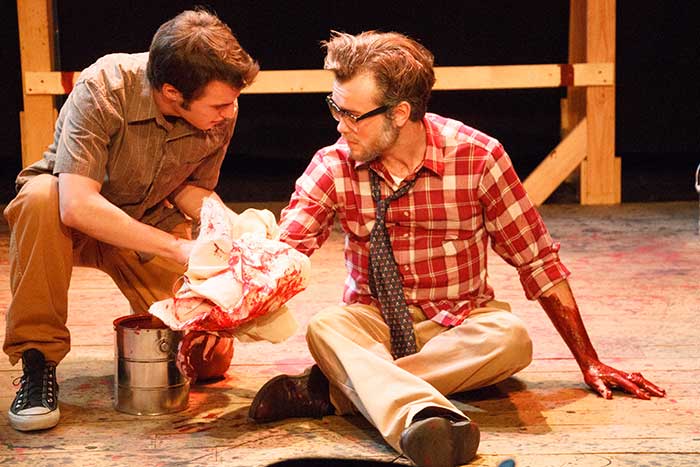When the Student Is the Master

While working on the most significant commission of his career, famed artist Mark Rothko (right, portrayed by Sam Neagley '14) finds himself elbow-deep in red paint, a shade that holds dark associations for his studio assistant, Ken (Dalton Maltz '16). Photo by Kathryn Davison '16.
Senior plays bring students' directorial vision to life
In a pivotal scene in John Logan’s 2009 play Red, a student teaches his master a lesson about life and art. And last weekend, a student-director did a bit of the same when she brought this Tony Award winning work to the Dickinson stage.
The Feb. 14-16 show was the first of two February productions directed by students; the second—Ellen Kaveevittayakun '14’s interpretation of Edward Albee's darkly comic The Goat, or Who is Sylvia?—comes to The Cubiculo Feb. 21-23. Like all senior-project arts productions in store this spring, each show represents a culminating moment in a student's academic career, drawing on all they've learned, in and out of the classroom, about their art.
Director Laura Colleluori ’14, a theatre & dance and Italian-studies major, fell in love with Red last summer while working as an intern with the Dallas Theater Center. After discussing it with Professor of Theatre Todd Wronski, she knew she had found her ideal senior production. She cast Sam Neagley ’14 as artist Mark Rothko, mired in existential crisis during a key moment in his career, and Dalton Maltz ’16 as Rothko’s studio assistant, Ken, and together, they tackled the play's exceptionally cerebral dialog.
“As a theater person, there's nothing more exciting than sinking your teeth into a really, really good script like this one,” said Colleluori of the work, which features dense, pages-long monologues and ample artistic and historical references. As a result, the director and actors needed to research not only the play's real-life subject, but also the lives and works of the thought leaders and artistic greats who influenced him.
"We're talking about full pages of text about Caravaggio, Matisse, Rembrandt and Nietzsche, and these speeches can be intimidating to act and direct, because they can easily become pedantic," Colleluori said. "So we did a lot of research and a lot of discussing, and I think it paid off."
Published February 18, 2014